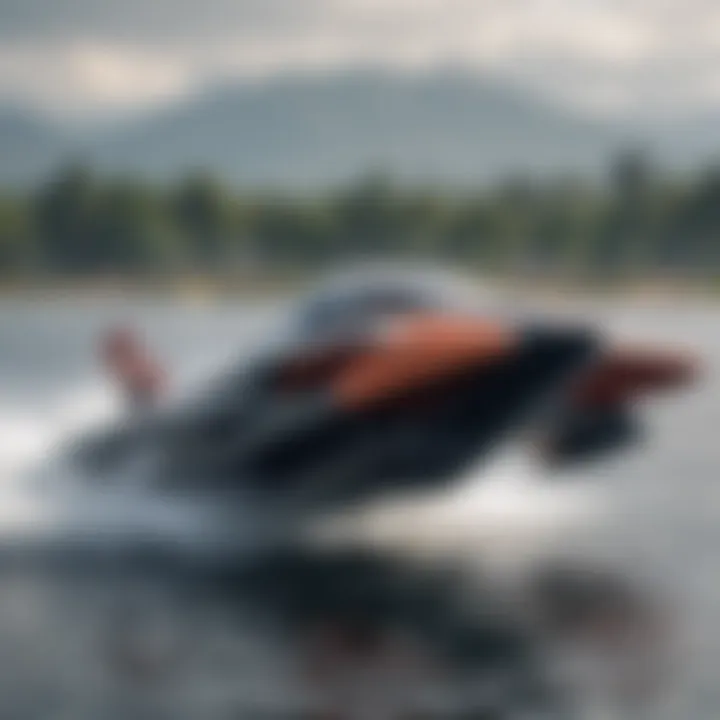Exploring the Dynamics of Wind Hydrofoils


Intro
The world of extreme sports is constantly evolving, with innovations pushing the boundaries of what enthusiasts can achieve. One such advancement is the emergence of wind hydrofoils, a cutting-edge technology that combines the thrill of wind power with the dynamics of hydrofoiling. This article delves into the operational principles and advantages of wind hydrofoils, while also addressing the associated challenges and design considerations.
Understanding wind hydrofoils requires a grasp of their lightweight construction and efficiency. As we explore this fascinating topic, we will examine their impact on performance and the current market trends. Furthermore, we will touch upon safety protocols essential for participants and the role these vessels play in enhancing the experience of thrill-seekers and adventure lovers.
By offering a detailed guide to wind hydrofoils, this piece serves to inform and inspire those within the extreme sports community, encouraging them to explore this exciting water sport.
Techniques and Tips
Skill Development
Learning to use wind hydrofoils effectively requires commitment and practice. Developing foundational skills such as balance, steering, and speed control will enhance your overall experience. Beginners should focus on mastering basic hydrofoil controls before attempting more advanced maneuvers.
Practical Techniques
When starting out, consider these techniques:
- Start Slow: Begin with light wind conditions to develop confidence.
- Maintain Balance: Keep your body centered over the board to prevent wobbling.
- Practice Turns: Take time to practice both manual and automatic turns to enhance responsiveness.
- Use Your Eyes: Look in the direction you want to go. This helps align your body and board movement.
Common Mistakes to Avoid
While practicing, be aware of these pitfalls:
- Oversteering: Adjusting too harshly can lead to loss of control.
- Ignoring Wind Patterns: Understanding wind behavior is vital for optimal performance.
- Neglecting Safety Gear: Always prioritize safety equipment to minimize potential injuries.
Gear and Equipment
Essential Gear for Beginners
As a novice, it is crucial to select suitable equipment that matches your skill level. Key components to invest in include:
- A beginner-friendly hydrofoil board
- A comfortable wetsuit for temperature regulation
- A reliable life jacket for safety
Latest Innovations and Trends
In the competitive hydrofoil market, brands are continuously innovating. Recent advancements focus on improving material strength, reducing weight, and enhancing overall performance. Notable brands in this space include Duotone and Lift Foils, known for their high-quality manufacturing and ergonomic designs.
Reviews and Comparisons
Researching and comparing different hydrofoil models can provide insights into what best suits your needs. Pay attention to performance ratings, user reviews, and durability when making your decision.
Safety Measures
Essential Safety Gear
Investing in safety gear is imperative when participating in wind hydrofoiling. Essential items include:
- Helmets to protect against falls
- Impact vests for additional cushioning
- Signal devices to stay alert in water
Best Practices for Safe Participation
Engaging in wind hydrofoiling also means adhering to safety practices:
- Avoid Crowded Areas: Choose spots where you have ample space to maneuver.
- Check Weather Conditions: Monitor wind and water conditions before heading out.
- Buddy System: Always have someone with you for assistance in case of emergencies.
Injury Prevention and Management
Staying safe while wind hydrofoiling means being proactive. Stretching before you engage in the sport can reduce the risk of injuries. Maintain a first-aid kit on hand and familiarize yourself with common injury management techniques.
Spotlights on Extreme Sports
Featured Sport of the Month
In this month’s spotlight, we highlight wind hydrofoiling as a rapidly growing sport. Its unique blend of agility and speed captivates a diverse group of enthusiasts eager to embrace the thrill of gliding above water.
Profiles of Prominent Athletes
Investigating the achievements of renowned hydrofoil athletes can be inspiring. Professionals like Nick Leason have paved the way, showcasing mastery of the sport and helping to refine techniques and safety approaches for newcomers.
The thrill of wind hydrofoiling represents not only a pastime but also a lifestyle full of adventure and connection with nature.
Foreword to Wind Hydrofoils
Wind hydrofoils represent a significant advancement in water sports technology. Their unique design allows riders to experience an exhilarating combination of speed and agility on water while leveraging the principles of aerodynamics and hydrodynamics. As thrill-seekers continue to pursue new adventures, understanding the dynamics of wind hydrofoils becomes crucial.
The benefits of wind hydrofoils lie not only in their performance capabilities but also in their versatility across various water conditions. This technology invites enthusiasts not just to participate in a sport but to indulge in a unique experience that intertwines the elements of wind and water. Within this article, we will explore key aspects of wind hydrofoils, including their components, operational principles, the advantages they offer, and the challenges they may present.
Definition and Overview
A wind hydrofoil is a specialized marine device that lifts the board above the water’s surface. This occurs through the use of underwater wings or foils, which create lift and reduce drag as the vessel moves. By elevating the board, these devices minimize the contact with water, leading to greater speed, performance, and an overall smoother ride.
Wind hydrofoils have gained popularity because they enable athletes to navigate various wind and water conditions efficiently, making them an appealing option for kiteboarding, windsurfing, and other water sports.
Historical Development of Hydrofoils
The concept of hydrofoils is not new; it traces back to the late 19th century. Initially, they were used in experimental boats designed to achieve higher speeds on water. The technology progressed, leading to the development of the first commercial hydrofoil boats in the 1950s. Since then, hydrofoils have transitioned to sports and recreational use, particularly with the rise of extreme sports in the late 20th century.
Notable milestones include the introduction of hydrofoil windsurfing in the 1980s, where riders began to appreciate the benefits of flying above the water. Over the years, materials technology has improved, leading to lighter and stronger constructions, which have further popularized wind hydrofoils in water sports. The ongoing interest in hydrofoiling reflects a blend of historical innovation and modern adventure pursuits.
Principles of Aerodynamics and Hydrodynamics
The principles of aerodynamics and hydrodynamics play a crucial role in understanding the operation and performance of wind hydrofoils. These fields of study are essential because they dictate how these innovative structures interact with both air and water. Their significance lies in enhancing the efficiency, stability, and speed of the hydrofoils. For enthusiasts and potential adopters, knowledge of these principles can make the difference in choosing the right equipment and optimizing performance in water sports.
Basic Concepts of Aerodynamics


Aerodynamics focuses on how air moves around objects. This is vital for wind hydrofoils since they are usually propelled by wind. The basic concepts include lift, drag, and airflow. Lift is the force that enables the hydrofoil to rise above the water’s surface. It is generated by the shape and angle of the foil against the wind, allowing for a smoother ride.
Here are some key terms to consider in aerodynamics:
- Lift: The upward force acting against gravity.
- Drag: The resistance force opposing motion through the air.
- Angle of Attack: The angle between the foil and the oncoming air.
Maximizing lift while minimizing drag is the objective of efficient hydrofoil design. By adjusting the angle of attack, riders can optimize performance under different wind conditions. Understanding these concepts is essential for both designers and users to ensure successful and thrilling experiences on the water.
Hydrodynamics in Water Sports
Hydrodynamics involves the study of fluids in motion, particularly how water interacts with solid bodies. For wind hydrofoils, this means understanding how water flows around the foil and affects the speed and stability of the ride. The principles of hydrodynamics can influence how the gear is designed to minimize water resistance, thereby improving speed and control.
Key concepts in hydrodynamics include:
- Buoyancy: The upward force that allows the hydrofoil to float.
- Lift in Water: Similar to air, lift enables the hydrofoil to rise above the water's surface when enough force is generated.
- Surface Tension: This plays a role in how the foil interacts with the water surface, affecting overall performance.
By grasping these hydrodynamic principles, thrill-seekers can enhance their technique, leading to a more exhilarating experience. Riders can explore performance potential and safety as they maneuver through waters, benefiting from increased understanding of how their equipment functions in fluid dynamics.
"The forces that influence both air and water behavior are interlinked. Recognizing their dynamics is key for optimal performance in wind hydrofoiling."
Components of Wind Hydrofoils
Understanding the components of wind hydrofoils is central to comprehending how this technology enhances performance in water sports. Each component contributes to the craft's effectiveness, stability, and safety. Moreover, knowing the elements allows enthusiasts to make informed decisions when selecting or customizing their gear. The key components include the foil structure and board and rigging systems, both of which are instrumental in achieving the desired hydrofoil experience.
Foil Structure
The foil structure is perhaps the most critical component in wind hydrofoils. It comprises the wings, fuselage, and mast. Each part plays a unique role in generating lift and ensuring stability. The wings are designed in various shapes and sizes, impacting the speed and maneuverability of the hydrofoil. Larger wings typically offer more lift, making them suitable for slower speeds, while smaller wings enable greater speed at the expense of stability.
The fuselage connects the wings to the mast and influences the overall rigidity of the hydrofoil system. A robust fuselage ensures consistent performance across different conditions. The mast, on the other hand, elevates the foil above the water, reducing drag and allowing for a smoother ride. Together, these elements must be precisely engineered to provide optimal performance in various water conditions.
Board and Rigging Systems
The board acts as the platform for the rider, influencing comfort and control. Hydrofoil boards are typically shorter and wider than standard boards to support the hydrofoil effectively. Their shape and material significantly affect buoyancy and responsiveness. When considering a board, factors such as weight, volume, and flex should be examined to match the rider's skill level and style.
Rigging systems also play an important role in connecting the sail to the foil. Proper rigging enhances stability and control. Different systems are available, with some allowing for quick adjustments to sail angle and tension based on wind conditions. Ensuring compatibility between the board and rigging is vital for maximizing performance.
The synergy between the foil structure and the board rigging is essential for an optimal hydrofoiling experience, enabling riders to harness wind energy effectively.
Attention to detail in selecting and understanding these components can significantly impact the performance and enjoyment of wind hydrofoiling. Thrill-seekers and extreme sports enthusiasts must be aware of how these components interact to choose the right setup for their capabilities.
Materials and Construction Techniques
Wind hydrofoils require specialized materials and construction techniques to optimize their performance on the water. These elements influence the hydrofoil's durability, buoyancy, and overall effectiveness. When considering these constructs, both lightweight materials and advanced manufacturing processes play critical roles in shaping the future of this technology.
Lightweight Materials Used
The use of lightweight materials is fundamental in the design and construction of wind hydrofoils. Lighter materials reduce the overall weight of the hydrofoil, leading to increased speed and enhanced maneuverability. Popular materials include carbon fiber and aluminum, which contribute to structural integrity without adding unnecessary heaviness.
- Carbon Fiber: This composite material is known for its high strength-to-weight ratio. Hydrofoils made from carbon fiber can withstand significant forces while remaining lightweight. Additionally, carbon fiber offers good stiffness, which leads to better performance in water.
- Aluminum: Another common material is aluminum. Although heavier than carbon fiber, it is more cost-effective and can be treated to withstand corrosion, making it a viable option for many hydrofoil users.
Using these materials can result in better lift and reduced drag, positively impacting the overall performance of wind hydrofoils in various water conditions.
Manufacturing Processes
The manufacturing processes applied to wind hydrofoils are crucial to ensuring quality and consistency in their performance. Several techniques are in use, each with its own set of advantages.
One significant method is prepreg manufacturing. In this process, carbon fiber is combined with a resin that is partially cured. This technique allows for greater precision when laying the fibers in a mold. The result is a more durable and uniform structure.
Another prevalent method is CNC machining. Using computer numerical control machines allows for highly accurate cutting and shaping of materials like aluminum. This precision is essential in forming parts that need to fit together seamlessly, enhancing the performance of the entire hydrofoil setup.
"Advanced manufacturing processes ensure that every hydrofoil is built to endure the rigors of extreme water sports, maintaining peak performance."
Finally, some manufacturers adopt techniques like vacuum infusion. This method applies vacuum pressure to draw resin into the fiber layers, ensuring a strong bond and reduced air bubbles. This results in a lighter, stronger end product that meets the demands of serious hydrofoil enthusiasts.
In summary, the choice of materials and the techniques employed in manufacturing greatly influence the performance and reliability of wind hydrofoils. The emphasis on lightweight construction helps enthusiasts push the limits of speed and agility on the water, essential for any growing sport.
Advantages of Using Wind Hydrofoils
Wind hydrofoils present distinct advantages that can greatly enhance the experience of water sports enthusiasts. They provide unique benefits that are important for both performance and enjoyment, which is why they are a key focus in this article. The advantages include efficiency, speed, and reduced water resistance. Understanding these aspects can inform potential users about the feasibility and advantages of integrating wind hydrofoils into their water sports repertoire.
Efficiency and Speed
One of the most celebrated benefits of wind hydrofoils is their potential for heightened efficiency. When a hydrofoil is in motion, it lifts the board above the water’s surface. This lift drastically reduces the wetted surface area. As a result, it creates less drag, allowing riders to reach higher speeds with less effort.
- Increased Performance: Riders can achieve significant performance advantages compared to traditional boards. The ability to fly above the surface can translate into a more streamlined ride, which means less energy is wasted.
- Wind Utilization: Hydrofoils make use of wind, which is a constant and renewable resource. Riders experience faster acceleration and top speeds by leveraging wind power effectively during their rides.
Reduced Water Resistance
Wind hydrofoils greatly reduce water resistance, a crucial element when considering performance in water sports. Traditional boards encounter significant drag due to their entire body being submerged. However, hydrofoils work on a different principle.
- Streamlined Design: The design of the hydrofoil minimizes the underwater profile, significantly cutting down resistance. This means less physical exertion is required to attain and maintain high speeds.
- Smoother Ride: The reduction in water resistance leads to a smoother ride through the water. Riders experience less interruption in their motion from waves and currents. As a result, not only does this enhance speed, but it also improves overall comfort on the water.
"The efficiency of wind hydrofoils opens up new possibilities for both competitive racing and recreational experiences on the water."
In summary, the advantages of using wind hydrofoils—efficiency, speed, and reduced water resistance—reflect their capability to transform how enthusiasts engage with water sports. These benefits underscore their relevance within the extreme sports community, as they allow for a more dynamic and exhilarating experience.
Challenges and Limitations
Understanding the challenges and limitations of wind hydrofoils is essential for appreciating their complexity and potential in the sport. The wind hydrofoil technology has advanced significantly, yet it faces various hurdles that enthusiasts must consider. Addressing these challenges ensures not only the safety of participants but also contributes to the evolution and acceptance of hydrofoiling in the broader water sports community.
Technical Challenges
Wind hydrofoils present several technical challenges that can impact performance and safety. Firstly, the design of the hydrofoil itself must strike a balance between lightweight construction and strength. If the material is too light, it may not withstand the stress of high-speed maneuvers; conversely, too much weight can negatively affect speed and agility.


Furthermore, integrating the foil with the board requires precise engineering. The connection points need to endure the forces generated during use without compromising the stability of the rider. This demands advanced manufacturing techniques and a deep understanding of the forces at play. These technicalities can complicate the crafting process, making high-quality wind hydrofoils often more expensive and less accessible to beginners.
Another notable issue is the learning curve associated with operating hydrofoils. Riders must develop skills to balance and maneuver effectively, which can deter many newcomers to the sport. Experience and practice are vital to overcome this initial hurdle.
Environmental Considerations
Environmental considerations play a crucial role in the discussion surrounding wind hydrofoils. While these devices are designed to harness natural wind and minimize resource consumption, their production can still have ecological impacts. The materials used, primarily composites and plastics, require energy-intensive processes that contribute to carbon emissions. As a result, advocates for sustainable practices urge manufacturers to explore eco-friendly alternatives that do not compromise on performance.
Additionally, the operation of hydrofoils must be respectful of marine ecosystems. Riders must be aware of sensitive habitats and local wildlife, especially in areas where marine species are abundant. Careless speed and maneuvering can disrupt these ecosystems, leading to potential conflicts with conservation efforts. As the popularity of this sport grows, so too does the scrutiny of its environmental footprint.
"Understanding the intricacies of wind hydrofoils, including their limitations, prepares enthusiasts for informed participation in the sport."
In summary, addressing the challenges and limitations of wind hydrofoils presents a need for a thoughtful approach in both technology and environmental responsibility. Whether it is enhancing performance through better materials or ensuring the sustainability of practices, the future of wind hydrofoiling will depend significantly on how these issues are managed.
Regulatory and Safety Considerations
Understanding regulatory and safety considerations is crucial for the development and enjoyment of wind hydrofoils. As this sport gains popularity among thrill-seekers, it is essential to establish a robust framework to promote safe practices while adhering to legal norms. By navigating through these facets, enthusiasts can enjoy the thrill of hydrofoiling while minimizing risks.
Safety Protocols
Implementing effective safety protocols is fundamental for all wind hydrofoil activities. Here are some vital protocols that must be considered:
- Personal Flotation Devices (PFDs): Wearing appropriate life jackets is a must. It ensures safety in case of falls or accidents on the water.
- Spotters and Buddy Systems: Engaging a spotter can help monitor conditions and assist during rides. A buddy system also ensures someone is always present to lend a hand if needed.
- Pre-ride Safety Checks: Before heading out, it is essential to check equipment, such as foils and boards, to ensure they are in good working condition.
- Environmental Awareness: Being vigilant of local conditions such as tides, currents, and weather forecasts is crucial to avoid hazardous situations.
- Emergency Preparedness: Riders should be equipped with basic first aid kits and know how to call for help if needed, especially when in remote areas.
"Safety is not just a protocol; it's a commitment to protecting yourself and others while enjoying the sport."
These protocols not only enhance safety but also empower riders to make informed decisions in unpredictable environments.
Legal Regulations
Legal regulations governing wind hydrofoiling can vary significantly depending on location. Understanding these rules is vital for compliance and safety. Consider the following elements:
- Permits and Licensing: Some regions may require specific permits to operate hydrofoils legally. Always check local regulations.
- Restricted Zones: Many coastal areas have designated zones where hydrofoiling may be prohibited. Riders must familiarize themselves with these areas to avoid fines.
- Insurance Requirements: Liability insurance may be necessary for individuals looking to rent equipment or participate in organized events. This can protect against potential accidents.
- Age Restrictions: Certain jurisdictions have age restrictions for operating hydrofoils. Adhering to these can prevent legal issues and ensure minors' safety.
- Regulatory Bodies: Organizations like the International Sailing Federation provide guidelines pertaining to water sports and can be a reliable source of updated regulations.
By understanding and adhering to legal regulations, hydrofoil enthusiasts contribute to a safer and more responsible riding community. This fosters a sustainable environment where everyone can enjoy the sport without adverse impacts.
Market Trends and Innovations
Wind hydrofoils represent a rapidly evolving segment of the water sports industry. As technology advances, so does the design and performance of these essential components. Understanding the market trends and innovations within this space is vital for enthusiasts and professionals alike. It not only highlights current preferences and demands but also underscores future possibilities for enhancing performance and accessibility.
Current Market Landscape
The current market for wind hydrofoils is expanding, with a noticeable increase in interest from both recreational users and competitive athletes. Various manufacturers are entering the space, each offering unique designs and features that cater to different skill levels and needs. Some key factors influencing the market include:
- Increased Participation: More people are engaging in activities like windsurfing and kitesurfing, driving demand for advanced equipment.
- Technological Advancements: Innovations in materials and design have made hydrofoils more efficient and accessible than ever.
- Environmental Trends: Consumers are increasingly conscious of their ecological footprint, leading to a rise in environmentally-friendly products.
Companies like Lift Foils and Slingshot Sports are shaping the market through their innovative designs and offerings that emphasize speed and stability. This has led to competitive pricing, giving buyers more options than before.
Innovations in Hydrofoil Technology
Innovation is at the heart of the wind hydrofoil market. Manufacturers are continuously experimenting with new technologies to enhance user experience and performance. Key innovations in hydrofoil technologies include:
- Improved Foil Design: Modern hydrofoils are being designed with hydrodynamic efficiency in mind. This leads to faster speeds and smoother rides, catering to thrill-seekers looking for a rush on the water.
- Smart Materials: The use of carbon fiber and other lightweight materials reduces the overall weight while maintaining structural integrity. Lighter foils facilitate easier maneuverability, essential for both beginners and advanced users.
- Adjustable Components: Some recently developed models allow for adjustability in wing size and placement, enabling users to customize their setup according to specific conditions and skill levels.
"The evolution of hydrofoil technology enhances not just performance, but also the overall enjoyment of water sports by making them more accessible and exhilarating."
The growth of wind hydrofoils represents a significant shift in water sports culture. As these trends continue to evolve, they will undoubtedly shape the future landscape of recreational and competitive activities, making it an exciting time for enthusiasts.
Performance Metrics and Assessments
Performance metrics and assessments are critical elements in understanding the efficiency and appeal of wind hydrofoils. They offer a way to quantify experiences and outcomes, crucial for both enthusiasts and manufacturers. Capturing data on speed, agility, and user satisfaction forms the foundation upon which advancements in hydrofoil design can be built. The focus on these metrics leads to an improved understanding of the technology's feasibility and effectiveness, influencing future developments in the sport.
Speed Tests and Comparisons
Speed tests serve as the backbone of performance evaluations in wind hydrofoiling. It is essential to establish benchmarks that reveal how various hydrofoils react under different wind and water conditions. Factors such as the foiling height, board shape, and material contribute to speed variations.
Some manufacturers conduct controlled environment assessments, while others rely on real-time feedback from riders in variable conditions. Such data is critical, not only for manufacturers to refine their products but also for riders to choose the right equipment to match their skill level and riding style.
When comparing speed metrics, it is worth noting that technology, design, and rider technique can drastically change results. A few notable observations include:
- Higher Aspect Ratios: Hydrofoils with higher aspect ratios often yield better speed due to reduced drag.
- Wing Shape: The shape of the wings influences lift and drag, impacting how quickly a hydrofoil can accelerate.
- Rider Positioning: The rider's stance and weight distribution can also affect speed, illustrating that human factors play a notable role in performance metrics.
Ultimately, engaging in speed comparisons requires both analytical perspectives and experiential evidence.
User Experience and Feedback
Understanding user experience is equally important as conducting speed tests. The subjective feedback from riders can highlight practical aspects that numbers alone may not convey. User experiences often include perceptions of stability, maneuverability, and overall enjoyment while riding.
Rider feedback may highlight several key points:
- Comfort: Stability during turns and ease of control are significant factors in a positive riding experience.
- Adaptability: How well a rider can adjust to changing conditions impacts both enjoyment and performance.
- Skill Progression: Riders often report their perception of improvement over time, which can be a motivating factor.
Gathering this feedback can be done through surveys, forums such as Reddit, or direct communication with the community. Engaging with forums not only provides insights but also helps to build a robust community around the sport.
"Performance metrics often extend beyond mere numbers; they encapsulate the essence of the experience for each rider."
Hydrofoil Competitions and Events
Hydrofoil competitions represent an essential aspect of the evolving field of wind hydrofoiling. They showcase the technical prowess of both participants and the equipment used. These events serve as critical platforms for innovation, performance testing, and community engagement within the sport. As the technology progresses, competitions highlight not only the skill of the riders but also the advancements in hydrofoil design and construction.
Overview of Competitions
In the realm of hydrofoiling, competitions range from casual local races to high-stakes international events. Noteworthy competitions include the Hydrofoil World Championship, and various national championships held across different countries. Each event typically features a series of races where participants are ranked by their speed and agility on the water.


Competitions often feature multiple categories based on skill level, age, or equipment type, accommodating a wide range of participants. This inclusive structure encourages newcomers while challenging experienced riders. Race formats can vary significantly, incorporating slalom courses, freestyle displays, and long-distance challenges.
These events not only promote healthy competition but also serve as a testing ground for new hydrofoil technologies. Manufacturers often use these platforms to showcase their latest innovations, from improved mast designs to enhanced foil shapes.
Impact on the Sport's Popularity
The rise of hydrofoil competitions has significantly impacted the popularity of the sport worldwide. As coverage grows through media and online platforms such as Reddit and Facebook, interest from spectators and potential participants soars. Competitions draw crowds, creating a vibrant atmosphere where atmosphere where enthusiasts can gather, learn, and share experiences.
Furthermore, high-profile events are instrumental in raising awareness about wind hydrofoiling. When top athletes showcase their skills and new technologies, it piques curiosity among those unfamiliar with hydrofoiling. The exposure provided increases not only engagement but also drives the market for hydrofoil equipment.
"The visibility of hydrofoil competitions has transformed the perception of the sport, positioning it as a legitimate and thrilling water activity."
In summary, hydrofoil competitions and events contribute to both the technical evolution and the community spirit of wind hydrofoiling. Their role is multidimensional, influencing advancements in technology, fostering competition, and significantly enhancing the popularity of the sport.
Community and Culture Surrounding Wind Hydrofoiling
The significance of community and culture in wind hydrofoiling cannot be overstated. As this sport grows in popularity, the relationships formed among enthusiasts become a vital source of support and motivation. This section looks deeper into the essence of the community and its culture, focusing on connections, shared experiences, and the role they play in promoting the sport.
Building a Community of Enthusiasts
Creating a community centered around wind hydrofoiling fosters connection among enthusiasts. This network often includes beginners eager to learn the sport and seasoned riders willing to share their knowledge and experiences. Many local clubs and groups organize events, meetups, and workshops that bring these individuals together. Participation in these gatherings can significantly enhance learning and development.
Social media platforms serve as an excellent medium for building this community. Websites like Facebook and Reddit feature dedicated groups where members exchange tips, showcase their latest rides, and discuss gear and techniques. These online interactions complement in-person gatherings, creating a robust support system that keeps members motivated.
Furthermore, competitions provide a platform for community engagement. Events not only highlight individual accomplishments, but they also promote a spirit of camaraderie and teamwork. As participants compete, they often form friendships that last beyond the event. This interconnectedness ultimately leads to a more vibrant culture surrounding wind hydrofoiling, where all are welcome, from novices to experts.
Cultural Impact of Hydrofoiling in Extreme Sports
Hydrofoiling fits seamlessly into the broader landscape of extreme sports. Its fast-paced nature and visually captivating performance have captured the interest of many thrill-seekers. As more people become aware of wind hydrofoiling, the sport garners attention from various media outlets, including social platforms and sporting events. This increased visibility contributes to its cultural impact and popularity.
Wind hydrofoiling contributes to the extreme sports culture through innovation and pushing boundaries. Riders are constantly challenging themselves to explore new techniques and stunts. The culture encourages participants to embrace risk and experimentation, reflective of the larger ethos found in extreme sports.
As hydrofoiling grows, it inspires a new generation of athletes. The accessibility of resources, such as instructional videos and community forums, lowers barriers to entry. This democratization of the sport allows diverse participants to engage, enriching the community tapestry.
As the wind drives the hydrofoil, the community propels the sport forward.
Training and Skill Development
The realm of wind hydrofoiling is not just about technology and equipment; it fundamentally relies on the skills of the individuals participating in the sport. Mastery of the hydrofoil requires a deep understanding of both the equipment and the conditions in which it operates. Training and skill development are crucial not only for safety but also for enhancing performance. As enthusiasts delve into this exciting activity, they must recognize that consistent practice and informed learning methods can significantly impact their overall experience.
Learning Curve for Beginners
For those venturing into the world of wind hydrofoils, the initial phase presents a steep learning curve. Many beginners find themselves grappling with the basic dynamics of balancing on the foil while simultaneously controlling their speed and direction.
Key considerations for beginners include:
- Understanding Foil Mechanics: Getting accustomed to how different foil shapes influence lift and drag can be quite enlightening. Multiple visits to local beaches or water sports centers help beginners familiarize themselves with different setups.
- Safety Protocols: Learning essential safety measures ensures that novice riders can practice without endangering themselves or others. It is vital to be aware of potential hazards in the water.
- Physical Conditioning: Physical strength and endurance are important. A good fitness level can boost performance and reduce risks of injury. Simple exercises focusing on core stability and flexibility can greatly help beginners.
It is also advantageous for newcomers to participate in community sessions or lessons led by experienced riders. This approach provides practical insights and can accelerate their learning process.
Advanced Techniques for Professionals
As one progresses beyond the basics, advanced techniques become essential for achieving high levels of performance. Professionals in the field often explore various aspects to enhance their skills, including:
- Fine-Tuning Board Settings: Mastering adjustments in foot straps, sail angles, and foil depth can lead to significant performance enhancements. Professionals experiment with their setups to optimize speed and improve maneuverability.
- Tactical Navigation: The ability to read water conditions, including swell patterns and wind shifts, is paramount for advanced practitioners. This skill enables professionals to make real-time decisions that affect their racing strategies and overall efficiency.
- Competition Techniques: Professionals often engage in formal competitions. They can benefit from studying rival techniques and strategies. Exposure to competitive events not only hones their skills but also fosters a greater understanding of the sport’s demands.
"The mastery of advanced hydrofoiling techniques is what separates good riders from the exceptional. Continual practice and assessment are vital."
Future of Wind Hydrofoiling
The future of wind hydrofoiling presents exciting opportunities and challenges in the realm of extreme sports and water-based activities. As technology advances, the potential for innovation in design, construction, and user experience will reshape how enthusiasts approach this thrilling sport.
Importance of the Topic
Understanding the future of wind hydrofoiling is crucial for several reasons. First, it highlights ongoing developments that promise improved performance, safety, and accessibility. Second, it indicates where market demand is heading, allowing manufacturers and developers to align their products with user needs. Finally, by identifying potential growth areas, both amateurs and professionals can make informed decisions about their participation and investments in this sport.
Predictions for Technological Advances
Technological advancements will significantly influence the future of wind hydrofoiling. Here are some key areas where innovations are anticipated:
- Material Science: The trend towards lighter, stronger materials is expected to continue. Innovations in carbon fiber and composite materials will enhance durability without sacrificing performance.
- Design Enhancements: Improved foil shapes and sizes will be developed to maximize lift and speed while minimizing drag. This could lead to designs that cater to various skill levels, making hydrofoiling more accessible.
- Integration of Smart Technology: Future hydrofoils may incorporate embedded sensors and tracking devices. These technologies can provide real-time feedback on performance metrics, helping users optimize their experience.
"As the sport evolves, the integration of smart tech will bridge the gap between traditional wind sports and modern innovation, ensuring a richer experience for all levels of users."
- Sustainable Practices: With a growing focus on environmental issues, advancements may also emphasize sustainable manufacturing processes. This can include recycling materials and reducing waste in production cycles.
Potential Growth Areas
Several growth areas have emerged within the world of wind hydrofoiling. These areas highlight the increasing appeal of the sport and the possibilities for expansion:
- Youth Programs: As interest in extreme sports rises, initiatives targeting youth could create new generations of enthusiasts. Schools and communities might offer hydrofoiling as part of their sports programs.
- Emerging Markets: Countries with vast coastlines, such as Brazil and South Africa, present untapped markets. As popularity spreads globally, these regions could become hotspots for wind hydrofoiling.
- Tourism and Experiences: Companies may develop tourism packages focusing on hydrofoiling experiences. This could integrate lessons with excursions for thrill-seekers who wish to engage with the sport while on vacation.
- Women in Hydrofoiling: Encouraging female participation can diversify the community and engender a new culture around the sport. Competitions and events specifically for women can boost interest and involvement.
Attention to these growth areas will not only shape the market but also enrich the community surrounding wind hydrofoiling, drawing in new talent and advocates for the sport.
Closure: The Evolution of Wind Hydrofoiling
The journey of wind hydrofoiling has been remarkable. It intertwines technology, sport, and the human spirit's pursuit of adventure. This conclusion emphasizes the significance of understanding wind hydrofoiling's evolution, as it provides insights into its growing presence in extreme sports. By analyzing its history, current trends, and future prospects, enthusiasts can appreciate its role and navigate the intricacies of this exciting sport.
Recap of Key Points
Wind hydrofoils are notable for their innovative design and functionality. Key points include:
- Efficiency: Their aerodynamic and hydrodynamic considerations make them faster and more efficient than traditional methods.
- Construction Materials: Lightweight materials, such as carbon fiber, play a crucial role in enhancing performance.
- Market Trends and Innovations: The growing demand for wind hydrofoils has led to a surge in companies focusing on technology improvements and user experience.
- Safety and Regulations: Understanding the necessary safety protocols is essential for users to enjoy the sport without undue risks.
As we explored these elements throughout the article, it becomes evident that wind hydrofoils are not just a fleeting trend but symbolize a significant shift in water sports.
Final Thoughts on the Sport's Trajectory
The future of wind hydrofoiling looks promising. Continuous advancements in technology and materials could lead to even greater performance gains. Furthermore, the sport could attract more enthusiasts, diversifying participation and fostering a vibrant community. The ability to glide above water will likely captivate a new generation of thrill-seekers.
"With each passing year, wind hydrofoiling continues to redefine the boundaries of water sports, offering exhilarating experiences that bridge the gap between innovation and adventure."







